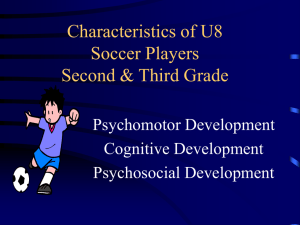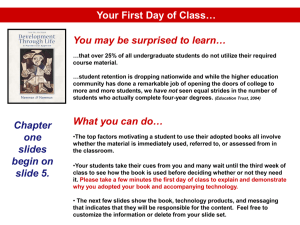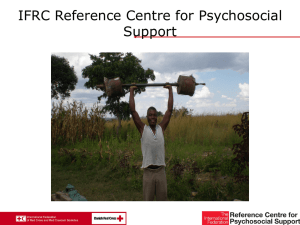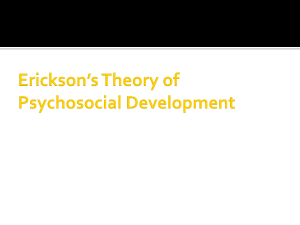Psychosocial Aspects of Reading with Low Vision
advertisement
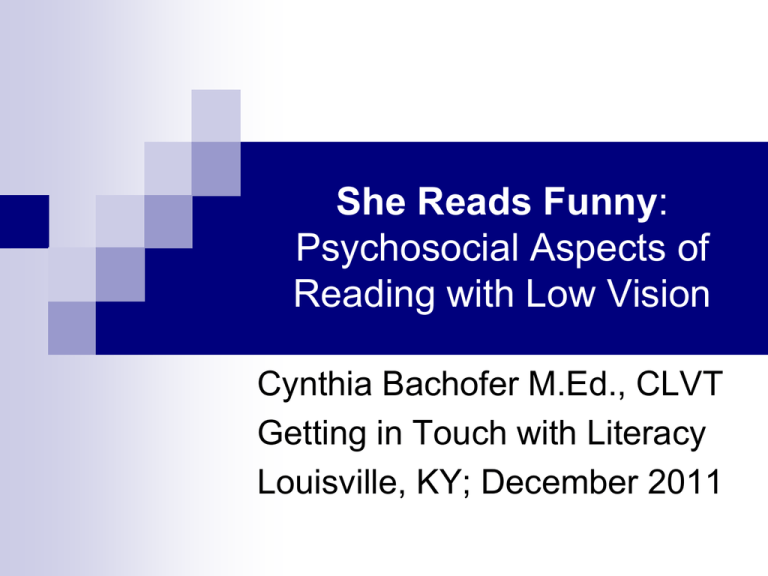
She Reads Funny: Psychosocial Aspects of Reading with Low Vision Cynthia Bachofer M.Ed., CLVT Getting in Touch with Literacy Louisville, KY; December 2011 Your early experiences in learning to read… Was learning to read an easy process for you? Was reading instruction a dreaded or a favorite time? Were you aware of how your reading skill compared to that of classmates? Reading of Standard School Text (Beginning to Read, M. Adadms, 1990) 90% of running text in school books consists of 5,000 common words 10% of text is uncommon words; these carry a disproportionate amount of meaning Children expected to learn 17 words per day Good readers need 4-5 instances of exposure to learn a word; poor readers need 10-12 exposures Overview of Presentation Reading as a personal task and as a public activity in school and community Additional factors of reading with low vision Summary of research studies Presentation of dissertation data Definition of Psychosocial Psychosocial factors: pertaining to one’s psychological development in the context of one’s social environment. Vision-related psychological factors include personal autonomy, functional independence, and psychological well-being. Psychosocial impact: the determinant of how a person perceives the benefit of a device on quality of life; interaction of user, device, and environment. Reading Experiences of Students with Low Vision Finding the right place on the page Looking closely at a page Reading as fast as peers Tiring quickly or needing breaks Hearing comments about reading behaviors Using different materials or devices Being singled out as needing additional supports Reading Experiences of Students with Low Vision Reading in a different way but accomplishing the assignment Knowing the text well because of slower reading Remembering features of a text that took more time to understand Making gains in comprehension because of dual input-audio and visual The Desperate State of Young Readers and Low Vision Research 7% of low vision research focuses on reading; 90% of low vision research refers to people who are 60+ years old Demographic data indicates that 10% or fewer of readers will use Braille but the majority of courses, textbooks that target VI literacy education will focus on Braille Present Levels of Literacy Functioning for Students with Low Vision (Carver, 1989) Review of the Literature Electronic database search in medical, rehab, and education (PubMed, Google Scholar, PsychInfo ) Keywords included 1. Psychosocial 2. Reading 3. Low vision 4. Optical devices 5. Children and students Exclusion terms: Reading strategies/processes, older adult focus, ADL/ILS studies 3 studies highlight psychosocial, reading, and students Low Vision Affects the Reading Process Quantitatively but not Qualitatively Reading has physical (visual) aspects AND psychological aspects Motivation, language skills (verbal cognitive ability), reading habits (lack of opportunities for incidental reading) Reading performance is determined greatly by reading experience Schooling is essentially the same for both groups Strategies of Low Vision Readers Sacrificing accuracy for speed may be a result of the pressure to keep up the reading pace with peers; adopt a guessing strategy Tend to rely on context rather than phonological or spelling patterns; less effective as text difficulty increases. reduced context (e.g., math, science,) Reading lag (speed, comprehension, and accuracy) increases with each school year Young readers often accept poor reading conditions: 1. unable to evaluate their needs; 2. want to be helpful Access to Print Literacy… Douglas, G. et al., 2011 Long-term difficulty in accessing text leads to developmental delays in reading (accuracy, speed, comprehension) Access to print literacy refers to both providing accessible materials (LP) and teaching access skills (e.g., optical devices) Reading assessment includes taking into account individual needs of comfort and sustainability: critical print size with preferred viewing distance; factors of vision (e.g., contrast, lighting needs) Reading as a social event: Classmates’ perception of low vision reading “. . . She can’t read too good . . . so if you’re her partner . . . she’s only on the first page and I’m on the second page. . . . Lisa’ll say “What’s this word?’ when you read and she only reads the easy words.” (Grade 1) “I think he’s pretty lucky. Because it’s easier to read the books and I’d get done faster if I had one of those (referring to large print text). (Grade 6) MacCuspie, A. (1996) Promoting Acceptance of Children with Disabilities. How Pupils … Describe Coping with Reading Activities (Vik & Lassen, 2010) Tension of many tools in the toolbox… Description of students’ subjective experiences (N=11, grades 5-10, use of print, Braille, audio) Coping questions: 1. Identify the impact of the stressor (demand); 2. Identify resources, strategies Coping strategies: Problem-focused, emotionfocused (Information-seeking, self-reliance; support-seeking, social isolation, helplessness) How Pupils … Describe Coping Some students used their communication skills (expressive-verbal) or help-seeking to compensate for poor reading skills and avoidance of reading; emotion-focused strategies allow relaxation, meaningful activities; social competence (peer and social support) led to inclusion and enjoyment of school Highly adapted education (audio literacy) minimized reading stress Active engagement gives platform for inclusion, peer acknowledgement Some problems/differences not solved, but endured Blurred Vision: A Study of the Use of Low Vision Aids (Mason, 1999) Primary aim: Establish a clearer understanding of the problem of known low usage and its possible causes Discovery: Lack of clearly defined criteria to determine if devices are being used effectively to 1.) support access to the curriculum and 2.) increase independence Secondary students; 107 schools in the UK Description of interviews Students with low vision User friendliness of devices Usage, reasons for reluctant usage Avoidance and coping strategies Friends of students Difficulty of curriculum access with device Awareness of coping strategies Attitudes of other pupils on LV student/device Teacher (vision specialist) Criteria to determine successful Reasons for reluctant usage usage use Teachers: Assessing Student Progress Willingness to use 25% Device used to gain access 22% Uses for appropriate tasks 20% Effective use 19% Speed of use 13% Reading speed 7% 0% 5% 10% 15% 20% 25% 30% Teachers: Causes of Reluctant Use 75% : Self-Conscious 50%: Peer pressure (perceived) 18%: Inadequate training, poor skills; Inconvenient to use or carry 14%: Other alternatives (e.g., large print, support staff); Device not available when needed 10%: Student does not identify as low vision; Lack of school, teacher’s support; Device does not help, barely helps Student Responses: Reluctance to Use Makes eyes tired 51% Feel different; Self-conscious 42% Restricted field of view 36% Device slows me down 35% Embarrassment 35% Teasing 27% Hard to use 9% Negative attitude from teachers 7% 0% 10% 20% 30% 40% 50% 60% Series1 Responses from Students on Coping Strategies Request help from teacher or peer Request enlarged work Complete work later or leave unfinished Comment on eye fatigue Device left at home or not with student Students: Best & Worst of device use “Helps me to be independent” vs. “Slows me down when I’m reading from the board.”; keeping up with classmates is the first goal. Responses from friends 38% of friends reported adverse comments from or negative attitudes of fellow students, primarily resentment of extra attention (e.g., more time in exams, enlarged papers, support staff) 40% of friends reported that they helped with reading from the white board, texts worksheets or student “would not be able to keep up”. Teacher Feedback Comments in interviews showed a high degree of subjectivity, vagueness, lack of consensus (e.g., effective device use, definition of reading speed) All teachers noted that large print was a way to adapt, access the curriculum (research on LP) Teachers noted device use was perceived as preventing student from keeping up in class; when available, large print or support staff seen as preferable over device use Psychosocial Aspects of Long Term Optical Device Use by Young Adults with Low Vision Descriptive data from dissertation: 32 adult participants (students previously enrolled in Project PAVE) who use devices completed phone interviews responding to personal characteristics, functioning with devices, and psychosocial aspects of use Quantitative data on factors of visual functioning, VI services, years of use, and response to reading Qualitative data from open-ended questions Psychosocial Aspects cont. Characteristics: 18 men, 14 women; 18-28 yrs (mean of 21.8); 19 were 21 or younger 30 used near devices (magnifiers, reading glasses); 27 used distance (telescopes) Factors of vision: No problems in central field (26); Sensitivity to light (27); peripheral field problem (16) Acuity: 20 between 20/200-400; 7 between 20/80-150; 2 as or <20/800; 3 no info Acuities in better eye 12 Number of participants 10 8 6 4 2 0 80 100 120 125 150 200 Acuity = 20/… 300 360 400 800 1600 Educational and VI services Services from a TVI: 27 (84%) in elementary; 5 (16%) in secondary years PAVE services: 18 (56%)in elementary; 13 (41%) in secondary years; 1 pre-school PAVE influence: 18 (56%) very positively influenced; 12 (38%) somewhat positively; 2 (6%) no impact Examples of Tasks Near 8: Pages of print (highest mean of 3.57 out of 5 on functioning scale) 6: Computer screen 5: Cell phone screen 3: Phone book/menus (2.13 on functioning) Distance 11: White board/ Powerpoint 5: Watching sports 3: Finding street signs/ watching TV, animals (highest mean of 3.33 out of 5 on functioning scale for travel signs) “Because of your low vision, are you having difficulty completing tasks?” 18: No 14: Yes 6: “It takes longer to do things.” 4: “Board work at school is hard.” 4: “Reading” (small print, typing and checking work) Influence of family/friends on device use Helpful/Encouraging 11: Reminded me (nagging) to use 8: Let me do things on my own, independent 4: Family learned about devices 4: No attention; it’s just something I use 32 gave responses Not supportive 17: No example 6: Teasing (limited) 5: Self-conscious, felt awkward (questions or comments) 3: People don’t know what it is, what it does 15 gave responses “What advice would you give… “ 2nd grader 12: Device can help you; it’s helpful to use 11: Don’t be ashamed, embarrassed, afraid 5: You can be successful, independent 5: It’s tough at first, but worth it 31 responses 10th grader 5: You need it to be responsible (tasks), meeting goals 4: Get over the idea of not being cool, popular 3: Think about your future (adult), the long run 15 responses Psychosocial aspects: Reading Preferred reading format with regular print: Near device: 15 (47%) No device: 11 (35%) Auditory: 5 (15%) Large print: 1 (3%) Percentage of format use: Print with device (45%); no device use (25%); auditory (15%); large print/enlarged (13%) Factors of Reading Read without tiring Read as fast Read as I want to different Print sizes YES 8 (25%) 14 (44%) 23 (72%) NO 24 (75%) 18 (56%) 9 (28%) Summary of Psychosocial Aspects Participants described a resigned willingness to use devices (limited tasks) “Self-presentation trumps access” continued, but less of an issue in adult world Recognized the differences of how peers complete the same tasks (speed, ease) Noted a sense of responsibility, achieving goals Told stories, gave advice, reflected on device use Final Notes Begin the conversation on psychosocial aspects of reading (device use) ; build student awareness of reading habits (skill/deficit), coping strategies, personal interests Teachers are data rich! Contribute to research: document progress, set reading goals and assess, involve student in the process “The Case of the Reluctant Reader” and uncovering clues… Help our students “to see reading as a door, not as a chore.” References Adams, M. (1990). Beginning to Read: Thinking and Learning about Print. Cambridge, Massachusetts, MIT Press. Bosman, A., Gompel, M., Vervloed, M., & van Bon, W. (2006). Low Vision Affects the Reading Process Quantitatively but not Qualitatively. The Journal of Special Education, 39, 208-19. Carver, R. (1989). Silent reading rates in grade equivalents. Journal of Reading Behavior, 21, pp. 158-161. Corn A., Wall R., Jose, R., Bell, J.K., Wilcox, K. and Perez, A. (2002). An initial study of reading and comprehension rates for students who received optical devices. Journal of Visual Impairment and Blindness, 95, 322-34. Douglas, G., Grimley, M., Hill, E., et al. (2002). The Case of the NARA for Assessing the Reading Ability of children with Low Vision. British Journal of Visual Impairment, 20, 68-75. References Douglas, G., McLinden, M., McCall, S., et al. (2011). Access to Print Literacy for Children and Young People with Visual Impairment: Findings from a Review of the Literature. European Journal of Special Needs Education, 16, 25-38. Erin, J. (2009). Practice Perspective: The Case of the Reluctant Reader: Insights from Three Professionals. Journal of Visual Impairment and Blindness, 103, 69-77. Goodrich, G.L. & Arditi, A. (2004). A Trend Analysis of the Low Vision Literature. The British Journal of Visual Impairment, 22, 105-6. MacCuspie, A. (1996). Promoting Acceptance of Children with Disabilities: From tolerance to inclusion. Atlantic Provinces Special Education Authority. Halifax, Nova Scotia. Mason, H. (1999). Blurred Vision: A Study of the Use of Low Vision Aids by Visually Impaired Secondary School Pupils. British Journal of Visual Impairment, 17, 94-97. References Spafford, M., Rudman, D.L., Leipert, B., et al. (2010). When Selfpresentation Trumps Access: Why Older Adults with Low Vision Go without Low Vision Services. Journal of Applied Gerontology, 29, 579-602. Vik, A.K. & Lassen, L.M. (2010). How Pupils with Severe Visual Impairment Describe Coping with Reading Activities in the Norwegian Inclusive School. International Journal of Disability, Development, and Education, 57, 279-98. Presenter email: bachoferc@tsbvi.edu
